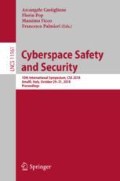Abstract
Biometric recognition is often affected by low quality images. This is especially true in iris recognition fields, due to the fact that the area of the iris is quite small and wrong detection are very common when standard iris detection methods are used, like the Hough transform. In this paper, the iris quality assessment of over 1200 images is achieved, from three different datasets. The evaluation of the iris is done by using shallow learning techniques. Two different experiments have been carried out and the results obtained show good accuracy performance on the test sets.
Access this chapter
Tax calculation will be finalised at checkout
Purchases are for personal use only
References
Abate, A., Barra, S., Gallo, L., Narducci, F.: SKIPSOM: Skewness Kurtosis of iris pixels in self organizing maps for iris recognition on mobile devices. In: 23rd International Conference on Pattern Recognition (ICPR) 2016, pp. 155–159 (Dec 2016). https://doi.org/10.1109/ICPR.2016.7899625
Abate, A.F., Barra, S., Gallo, L., Narducci, F.: Kurtosis and skewness at pixel level as input for SOM networks to iris recognition on mobile devices. Pattern Recogn. Lett. 91, 37–43 (2017). https://doi.org/10.1016/j.patrec.2017.02.002, http://www.sciencedirect.com/science/article/pii/S0167865517300338. mobile Iris CHallenge Evaluation (MICHE-II)
Abate, A.F., Barra, S., Fenu, G., Nappi, M., Narducci, F.: A lightweight mamdani fuzzy controller for noise removal on iris images. In: Battiato, S., Gallo, G., Schettini, R., Stanco, F. (eds.) ICIAP 2017. LNCS, vol. 10485, pp. 93–103. Springer, Cham (2017). https://doi.org/10.1007/978-3-319-68548-9_9
Barra, S., Casanova, A., Narducci, F., Ricciardi, S.: Ubiquitous iris recognition by means of mobile devices. Pattern Recogn. Lett. 57, 66–73 (2015). https://doi.org/10.1016/j.patrec.2014.10.011, http://www.sciencedirect.com/science/article/pii/S0167865514003286, mobile Iris CHallenge Evaluation part I (MICHE I)
Daugman, J.: How iris recognition works. In: The essential guide to image processing, pp. 715–739. Elsevier (2009)
De Marsico, M., Nappi, M., Daniel, R.: IS\_IS: Iris segmentation for identification systems. In: Pattern Recognition (ICPR), 20th International Conference on 2010, pp. 2857–2860. IEEE (2010)
De Marsico, M., Nappi, M., Riccio, D., Wechsler, H.: Mobile iris challenge evaluation (MICHE)-I, biometric iris dataset and protocols. Pattern Recogn. Lett. 57, 17–23 (2015)
Fenu, G., Marras, M., Boratto, L.: A multi-biometric system for continuous student authentication in e-learning platforms. Pattern Recogn. Lett. (2017). https://doi.org/10.1016/j.patrec.2017.03.027, http://www.sciencedirect.com/science/article/pii/S0167865517300909
Galbally, J., Marcel, S., Fierrez, J.: Image quality assessment or fake biometric detection: application to iris, fingerprint, and face recognition. IEEE Trans. Image Process. 23(2), 710–724 (2014)
He, X., Lu, Y., Shi, P.: A fake iris detection method based on FFT and quality assessment. In: Pattern Recognition, CCPR 2008 Chinese Conference on 2008, pp. 1–4. IEEE (2008)
Illingworth, J., Kittler, J.: A survey of the hough transform. Comput. Vis. Graph. Image Process. 44(1), 87–116 (1988)
Jenadeleh, M., Pedersen, M., Saupe, D.: Realtime quality assessment of iris biometrics under visible light. In: CVPR 2018: IEEE/CVF Conference on Computer Vision and Pattern Recognition, pp. 556–565 (2018)
Kalka, N.D., Zuo, J., Schmid, N.A., Cukic, B.: Estimating and fusing quality factors for iris biometric images. IEEE Trans. Syst. Man Cybern. Part A Syst. Hum 40(3), 509–524 (2010). https://doi.org/10.1109/tsmca.2010.2041658. http://gen.lib.rus.ec/scimag/index.php?s=10.1109/tsmca.2010.2041658
Neves, J.C., Moreno, J.C., Barra, S., Proena, H.: Acquiring high-resolution face images in outdoor environments: a master-slave calibration algorithm. In: 2015 IEEE 7th International Conference on Biometrics Theory, Applications and Systems (BTAS), pp. 1–8 (Sept 2015). https://doi.org/10.1109/BTAS.2015.7358744
Proença, H.: Quality assessment of degraded iris images acquired in the visible wavelength. IEEE Trans. Inf. Forensics Secur. 6(1), 82–95 (2011)
Proença, H., Alexandre, L.A.: UBIRIS: a Noisy Iris Image Database. In: Roli, F., Vitulano, S. (eds.) ICIAP 2005. LNCS, vol. 3617, pp. 970–977. Springer, Heidelberg (2005). https://doi.org/10.1007/11553595_119
Wei, Z., Tan, T., Sun, Z., Cui, J.: Robust and fast assessment of iris image quality. In: Zhang, D., Jain, A.K. (eds.) Advances in Biometrics, pp. 464–471. Springer, Berlin (2005). https://doi.org/10.1007/11608288_62
Acknowledgments
Mirko Marras gratefully acknowledges Sardinia Regional Government for the financial support of his PhD scholarship (P.O.R. Sardegna F.S.E. Operational Programme of the Autonomous Region of Sardinia, European Social Fund 2014-2020, Axis III “Education and Training”, Thematic Goal 10, Priority of Investment 10ii, Specific Goal 10.5). The Italian Ministry of University, Education and Research (MIUR), partially supported this work, under the project ILEARNTV (announcement 391/2012, SMART CITIES AND COMMUNITIES AND SOCIAL INNOVATION).
Source Code. In order to have the source code of the method, along with the experimental data.
Author information
Authors and Affiliations
Corresponding author
Editor information
Editors and Affiliations
Rights and permissions
Copyright information
© 2018 Springer Nature Switzerland AG
About this paper
Cite this paper
Abate, A.F., Barra, S., Casanova, A., Fenu, G., Marras, M. (2018). Iris Quality Assessment: A Statistical Approach for Biometric Security Applications. In: Castiglione, A., Pop, F., Ficco, M., Palmieri, F. (eds) Cyberspace Safety and Security. CSS 2018. Lecture Notes in Computer Science(), vol 11161. Springer, Cham. https://doi.org/10.1007/978-3-030-01689-0_21
Download citation
DOI: https://doi.org/10.1007/978-3-030-01689-0_21
Published:
Publisher Name: Springer, Cham
Print ISBN: 978-3-030-01688-3
Online ISBN: 978-3-030-01689-0
eBook Packages: Computer ScienceComputer Science (R0)

